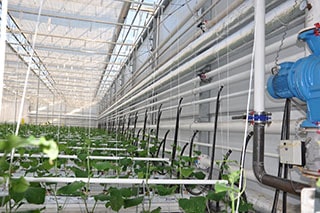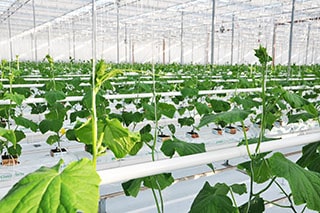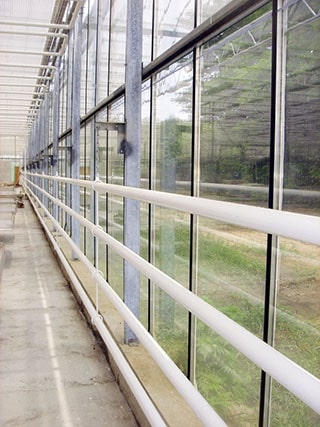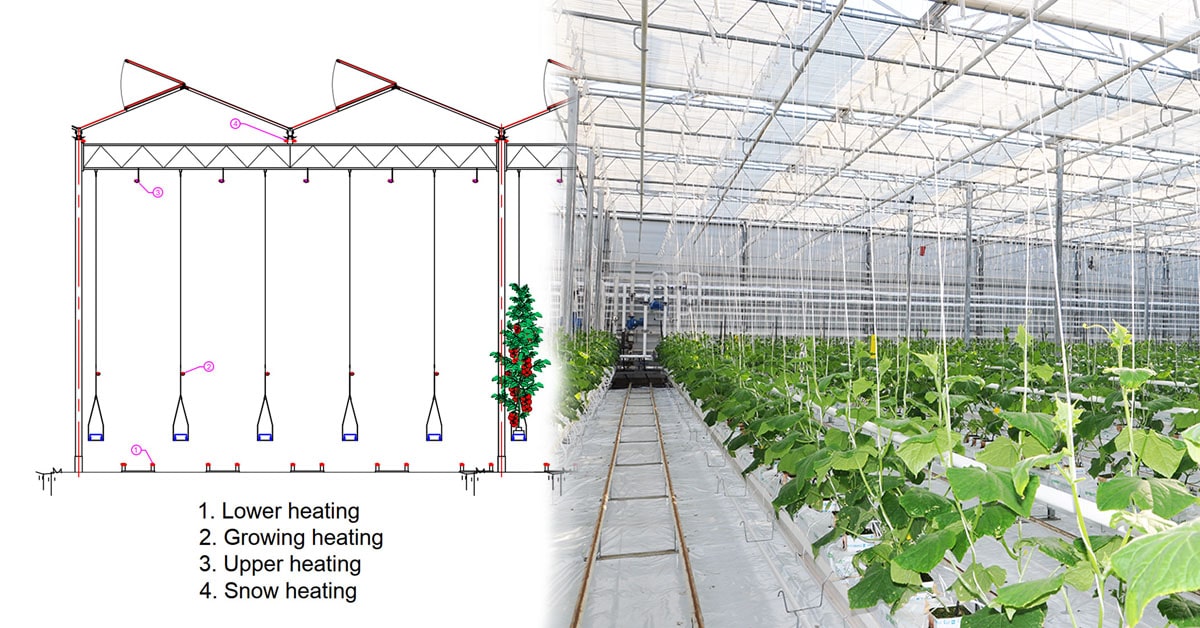When it comes to growing tomatoes, cucumbers, sweet peppers and often with many other vegetables and plants, there is one heating system layout within a growing area which produces best results. In this post I will try to cover the main elements of this heating system.
Within a growing area the heating systems are as following:
- Lower heating also known as the Pipe-Rail system;
- Upper heating;
- Growing heating;
- Snow heating;
Location of each system can be seen in the following drawing:

This heating systems have 4 purposes:
- Heating;
- Humidity control;
- Melting the snow;
- Transportation system between the plant rows;

All heating system pipes are welded, made out of steel, and painted with white non-toxic paint in two layers. Insulated pipes are not painted.
- Lower heating system is composed out of 10 pipes Ø51mm (2 inches), 2,25mm ( 0.0886 inches) wall thickness;
- Upper heating system is composed out of 5 pipes Ø 51mm (2 inches), 2,25mm ( 0.0886 inches) wall thickness;
- Growing heating system is composed out of 5 pipes Ø 38mm, 2,00mm ( 0.0787 inches) wall thickness;
- Snow heating system is composed out of 4 pipes Ø 51mm (2 inches), 2,25mm ( 0.0886 inches) wall thickness;

The highest heating water temperature is in the lower heating system up to 95 °C (203 °F), then the colder water runs through the upper heating system at around 75 °C (167 °F), but can also be 95 °C (203 °F) if needed. And the coldest water goes through the growing heating between the plants, from 45 °C (113 °F) up to 60 °C (140 °F),.
Snow heating pipes, when active always runs on 95 °C (203 °F), if available.
Pressure in the system is around 1bar (14.5 psi).
Expansion units are always used.
The optimal climate zone surface for heating and other greenhouse systems is around 6000 m2 (1.5 acres).

Each climate zone must have their separate mixing groups, and within each mixing group each system must have its dedicated pump, three way mixing valve and other companion equipment like thermostats, sensors, valves etc. This is very important in order for the heating system to have a functionality to act independently. This way an optimal climate can be achieved through the whole greenhouse, even without a wall separating each climate zone.
There are also “wall heating” pipes, usually 4 -6 pipes Ø51mm (2 inches), but they are not a separate heating system. Most of the time they are fed by the water from the lower heating system.
If the greenhouse is heated by geothermal water of 85 °C (185 °F) or higher, then the heating system layout within the growing area is the same as if the greenhouse would be heated by gas boilers.
But if the geothermal water temperature is lower, 65 °C (149 °F) or even 45 °C (113 °F), then the heating pipes layout is different. More steel pipes are needed.
This is a whole new subject…. In periods of extreme cold weather, how to make the boilers a supplement and avoid them being a total replacement of geothermal energy. Thus making the geothermal run all the time during the heating season, and boilers run periodically only at its necessary minimum, while making a huge savings in gas expenses. All this with a very low temperature geothermal water, as low as 40-45 °C (104-113 °F).



0 Comments